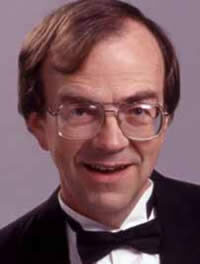French composer Jacques Offenbach (1819-1890) was born in Germany and was best known for his operettas filled with what Andrew Lamb, in the online edition of The New Grove Dictionary of Music and Musicians II, accurately calls “some of the most exhilarating gay and tuneful music ever written.” His last opera, Les Contes d’Hoffmann, is based upon the life and fantastic stories of German Romantic author, composer, and opera impresario E.T. A. Hoffmann (1776-1822). Offenbach desperately wanted this last dramatic work to establish his reputation as a “serious composer.” Alas, Offenbach died during the rehearsals for this opera at the Opéra-Comique in Paris. Ernest Guiraud orchestrated the piece, applying “tidying up” with a heavy hand, dropping the entire Giulietta act, and re-locating the Antoinia act to Venice just to make use of the famous barcarole. This was just the first of many wholesale re-workings of the score that were only “corrected” by several “authentic” editions in the 1970’s.
Les Contes d’Hoffmann has a five-act structure set in Nuremburg, Munich and Venice. Director Lillian Groag’s staging was unusually effective. Groag up-dated the opera’s period from the nineteenth century to the “flapper era” of the 1920’s in the Weimar Republic in Germany. This was the 14th production she has done for the Virginia Opera Company. In her intriguing Stage Director’s Notes, Groag mentions her childhood fascination with the on-stage gondolas in the Venice act, and there were quite a large number of gondolas on this production’s canals!
Virginia Opera’s Artistic Director Peter Mark informed us he chose the Choudens edition of Hoffmann, placing the Giulietta Act after the Antonia Act, because of better dramatic effect and “in order to align the increasingly heavy vocal weights required in the (lead) soprano roles as they are taken in this case by one soprano.” This production of Hoffman was cast from strength with outstanding singer-actors in the lead roles and strong support from the rest of the cast.
The performance of French soprano Manon Strauss Evrard as Hoffmann’s four loves, Olympia, Antonia, Giulietta, and Stella had been eagerly anticipated and more than met the promise of the scuttle-butt. The first three roles thoroughly test a soprano’s mettle. There were times I thought of the extremely pure notes of a platinum flute as Evrard hit every high note of the mechanical doll Olympia’s stratospheric upper reaches during the aria “Les oiseaux dans la charmille.” Her intonation was unbelievably precise. The tragic role of Antonia gave scope for Evrard’s solid lower range and allowed the warmth of her sound to be exploited. Evrard melded these fine vocal qualities and added power to the mix as she pulled out the stops as the cruel Venetian courtesan Giulietta. Stella required only brief acting and speaking. In addition to bringing a unique sound to these roles, Evrard provided elaborately unique impersonations for each character.
Turkish bass Burak Bilgili was delightful as Hoffmann’s four sinister villains, Lindorf, Coppélius, Dr. Miracle, and Dapertutto. He only lacked a mustache to twirl like a silent movie heavy. His natural stage presence combined with menacing facial make up helped him dominate scenes. The sepulchral darkness of Bilgil’s rock-solid low range added to the threatening effect. Yet his voice was flexible enough to easily negotiate Dapertutto’s tribute to the seductive power of diamonds, “Scintille, diamond….”
Tenor Dan Snyder was terrific in the title role, Hoffmann, melding an even, strongly supported voice with flexibility and gorgeous head tone. His warm timbre was pleasing, his high notes were spot-on and ringing, and his diction was outstanding. Snyder was perfect as the poet constantly blinded by love. He captured Hoffmann’s character perfectly in his first aria in the prologue, “Il était une fois à la cour d’Eisenach,” as he drifted from the comic description of a dwarf into a reverie, rhapsodizing about his lady-love. Another highlight was Snyder’s ecstatic duet with Evrard in Act IV, “Si ta presence m’est ravie,” during which Hoffmann loses his reflection.
The dual role of Hoffmann’s Muse as well as his “sidekick” Nicklausse was taken by mezzo-soprano Sonia Gariaeff. Her timbre was warm and pleasing and her skilled application of male body language made her portrayal of Hoffmann’s young male confidant all the more convincing. An unusual touch was to have the barcarolle duet, “Belle nuit, ô nuit d’amour,” sung by Evrard and Gariaeff as they writhed in a passionate embrace in a gondola floating across the stage’s canal. As Hoffmann’s Grecian Muse, she was moving as she summoned the poet back to creativity. In this production, Gariaeff also sang Antoinio’s dead mother’s voice, Nicklausse, acting as a puppet controlled by one of Dr. Miracle’s wraiths.
Heading the fine supporting cast were tenor Dean Anthony as Andrès, Spalazani, Franz, and Pittichinaccio, and the rich voiced bass-baritone Brian McIntosh as Luther and Crespel. The roles of Nathaniel and Cochenille were taken by tenor Aaron Logan. Hermann and Schlemil were portrayed by baritone Brian Jagde.
Artistic Director Peter Mark led members of the Virginia Orchestra in a gorgeously phrased and played treatment of the score. His alert and flexible conducting kept tight coordination between the pit and the stage. There were sensitive solos from concertmaster Vahn Armstrong and clarinetist Patti Ferrell Carlson. The strings were silken and magical during the barcarolle. The horns, led by David Wick, were glorious. The chorus was superb in its varied roles and the four dancers, choreographed by Jessica Page, were dramatically effective.
The effective and imaginative sets were designed by Erhard Rom and were subtly lighted by Mark McCullough. Designer Martha Hally’s costumes, such as soprano Evrard’s four incarnations, were a feast for the eyes. Instead of the standard portrait of Antonia, Hally had a tableau vivant, a statue of the mother, that was joined by one of the daughter at Antonia’s death.











